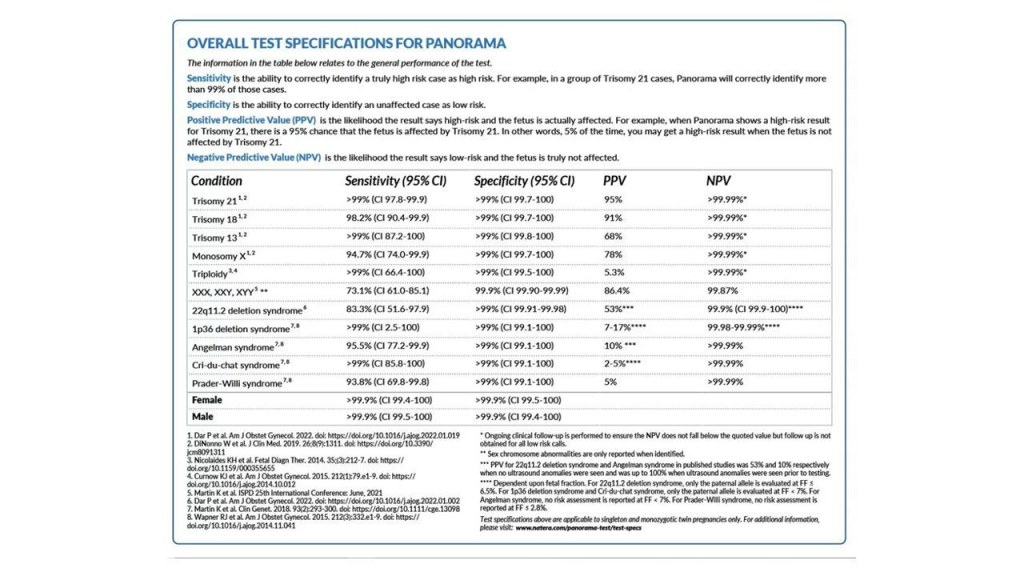What Is Panorama Test? Discover The Power Of Genetic Screening Now!
What is Panorama Test: A Comprehensive Overview
Greetings, Happy People! In this article, we will delve into the topic of the Panorama Test, providing you with a comprehensive understanding of its purpose, benefits, and limitations. Whether you are an expecting parent or a curious individual, this article will equip you with the knowledge you need to navigate the world of prenatal testing. So, without further ado, let’s dive in!
Introduction
The Panorama Test is a non-invasive prenatal screening test that uses advanced genetic technology to detect the risk of certain chromosomal abnormalities in the fetus. This innovative test analyzes the cell-free DNA present in the mother’s blood, providing accurate and reliable results. By examining the baby’s DNA, the Panorama Test can assess the likelihood of genetic conditions such as Down syndrome, Edwards syndrome, Patau syndrome, and several sex chromosome abnormalities.
2 Picture Gallery: What Is Panorama Test? Discover The Power Of Genetic Screening Now!
The main objective of the Panorama Test is to provide expectant parents with valuable information about their baby’s health early in the pregnancy. This information can help parents make more informed decisions regarding their prenatal care and potential treatment options. Additionally, the Panorama Test can offer peace of mind to parents by confirming that their baby has a low risk of the conditions screened for.
Now, let’s explore the key aspects of the Panorama Test in detail.
What is the Panorama Test?

Image Source: lifelabsgenetics.com
🔍 The Panorama Test is a non-invasive prenatal screening test that detects the risk of chromosomal abnormalities in the fetus. It analyzes the cell-free DNA in the mother’s blood to assess the likelihood of genetic conditions such as Down syndrome, Edwards syndrome, Patau syndrome, and sex chromosome abnormalities.
The Panorama Test uses a method called cell-free DNA (cfDNA) screening to analyze the baby’s genetic material, which is naturally released into the mother’s bloodstream during pregnancy. This cfDNA is then extracted from the maternal blood sample and undergoes advanced sequencing and analysis to identify any chromosomal abnormalities.
The Panorama Test has a high detection rate and low false-positive rate, making it a reliable screening option for expectant parents. It can be performed as early as nine weeks into the pregnancy, offering early insights into the baby’s health status.
Who Should Consider the Panorama Test?
🔍 The Panorama Test is recommended for all expectant parents who want to gain comprehensive information about their baby’s health and genetic profile. It is particularly relevant for women who have an increased risk of chromosomal abnormalities due to factors such as advanced maternal age or a previous pregnancy with a chromosomal condition.

Image Source: innermosthealthcare.com
Additionally, the Panorama Test can be beneficial for couples who are carriers of certain genetic disorders and wish to determine the risk of passing them on to their child. It is important to consult with a healthcare provider or genetic counselor to assess whether the Panorama Test is suitable for your specific circumstances.
When Can the Panorama Test Be Done?
🔍 The Panorama Test can be performed as early as nine weeks into pregnancy. This early testing window allows expectant parents to receive crucial information about their baby’s health and make informed decisions regarding their pregnancy care.
It is essential to note that the timing of the test may vary depending on specific healthcare providers and individual circumstances. It is advisable to consult with a healthcare professional to determine the most appropriate time for you to undergo the Panorama Test.
Where Can You Get the Panorama Test?
🔍 The Panorama Test is offered by various healthcare providers, including specialized laboratories and hospitals. It is important to consult with your healthcare provider or genetic counselor to discuss the availability and accessibility of the Panorama Test in your area.
Once you decide to undergo the Panorama Test, your healthcare provider will guide you through the process, including scheduling the test, providing necessary instructions, and interpreting the results.
Why Should You Consider the Panorama Test?
🔍 The Panorama Test offers several significant advantages for expectant parents. Firstly, it is non-invasive, meaning it does not pose any risk to the mother or the fetus. This makes it a safe and reliable screening option, especially when compared to invasive diagnostic procedures such as amniocentesis.
Secondly, the Panorama Test provides highly accurate results, with a detection rate of over 99% for certain chromosomal abnormalities. This accuracy allows parents to make informed decisions about their prenatal care and potential treatment options.
Thirdly, the Panorama Test can provide early insights into the baby’s health, allowing parents to prepare emotionally and practically for the arrival of their child, should further medical interventions or support be required.
On the other hand, it is essential to consider the limitations of the Panorama Test. While it is highly accurate, it is still a screening test and not a diagnostic test. This means that any positive results should be confirmed with further diagnostic testing, such as amniocentesis or chorionic villus sampling, for a definitive diagnosis.
How Does the Panorama Test Work?
🔍 The Panorama Test involves a simple and straightforward process. After scheduling the test with your healthcare provider, a blood sample will be taken from the expectant mother. This blood sample contains the cell-free DNA from the fetus, which will be analyzed in a specialized laboratory.
The laboratory technicians will extract the cfDNA from the blood sample and subject it to advanced sequencing and analysis processes. These processes involve examining the genetic material for any chromosomal abnormalities and comparing it to a reference DNA database.
Once the analysis is complete, the laboratory will provide a comprehensive report detailing the results of the Panorama Test. This report will indicate the risk of specific chromosomal abnormalities in the fetus, allowing expectant parents to make informed decisions about their pregnancy care and potential treatment options.
Advantages and Disadvantages of the Panorama Test
Advantages:
1️⃣ Highly accurate results, with a detection rate of over 99% for certain chromosomal abnormalities.
2️⃣ Non-invasive and safe for both the mother and the fetus, with no risk of miscarriage.
3️⃣ Early testing window, allowing expectant parents to receive crucial information about their baby’s health and make informed decisions.
4️⃣ Can provide peace of mind by confirming a low risk of certain genetic conditions.
5️⃣ Can identify the risk of passing on genetic disorders for carrier couples.
Disadvantages:
1️⃣ The Panorama Test is a screening test, and any positive results should be confirmed with further diagnostic testing for a definitive diagnosis.
2️⃣ It may not detect all chromosomal abnormalities, and there is a small chance of false-positive or false-negative results.
3️⃣ The cost of the Panorama Test may not be covered by insurance, making it a financial consideration for some individuals.
Frequently Asked Questions (FAQs)
1. Is the Panorama Test covered by insurance?
🔍 The coverage of the Panorama Test by insurance varies depending on individual insurance plans. It is recommended to contact your insurance provider to determine if the test is covered and to understand any associated costs.
2. Can the Panorama Test detect all genetic conditions?
🔍 While the Panorama Test is highly accurate, it does not screen for all genetic conditions. It specifically focuses on detecting the risk of certain chromosomal abnormalities, such as Down syndrome, Edwards syndrome, Patau syndrome, and sex chromosome abnormalities.
3. Are there any risks involved in undergoing the Panorama Test?
🔍 The Panorama Test is a non-invasive screening test and does not pose any risks to the mother or the fetus. It does not increase the risk of miscarriage, making it a safe option for expectant parents.
4. Can the Panorama Test determine the gender of the baby?
🔍 Yes, the Panorama Test can determine the gender of the baby with high accuracy. This information can be particularly exciting for parents who wish to know the sex of their baby early in the pregnancy.
5. How long does it take to receive the results of the Panorama Test?
🔍 The turnaround time for the Panorama Test results typically ranges from seven to ten days. However, this can vary depending on the laboratory and other factors. Your healthcare provider will provide you with an estimated timeline for receiving the results.
Conclusion
In conclusion, the Panorama Test is a valuable tool for expectant parents seeking comprehensive information about their baby’s health. With its non-invasive nature, high accuracy, and early testing window, the Panorama Test offers numerous advantages for individuals navigating the journey of pregnancy. However, it is crucial to consider its limitations and the need for further diagnostic testing in the case of positive results. Consulting with a healthcare provider or genetic counselor is essential to determine the suitability and availability of the Panorama Test for your specific circumstances.
Final Remarks
The information provided in this article is intended for educational purposes only and should not replace professional medical advice. It is always recommended to consult with a healthcare provider or genetic counselor for personalized guidance and support regarding prenatal testing and care.
This post topic: Panorama


